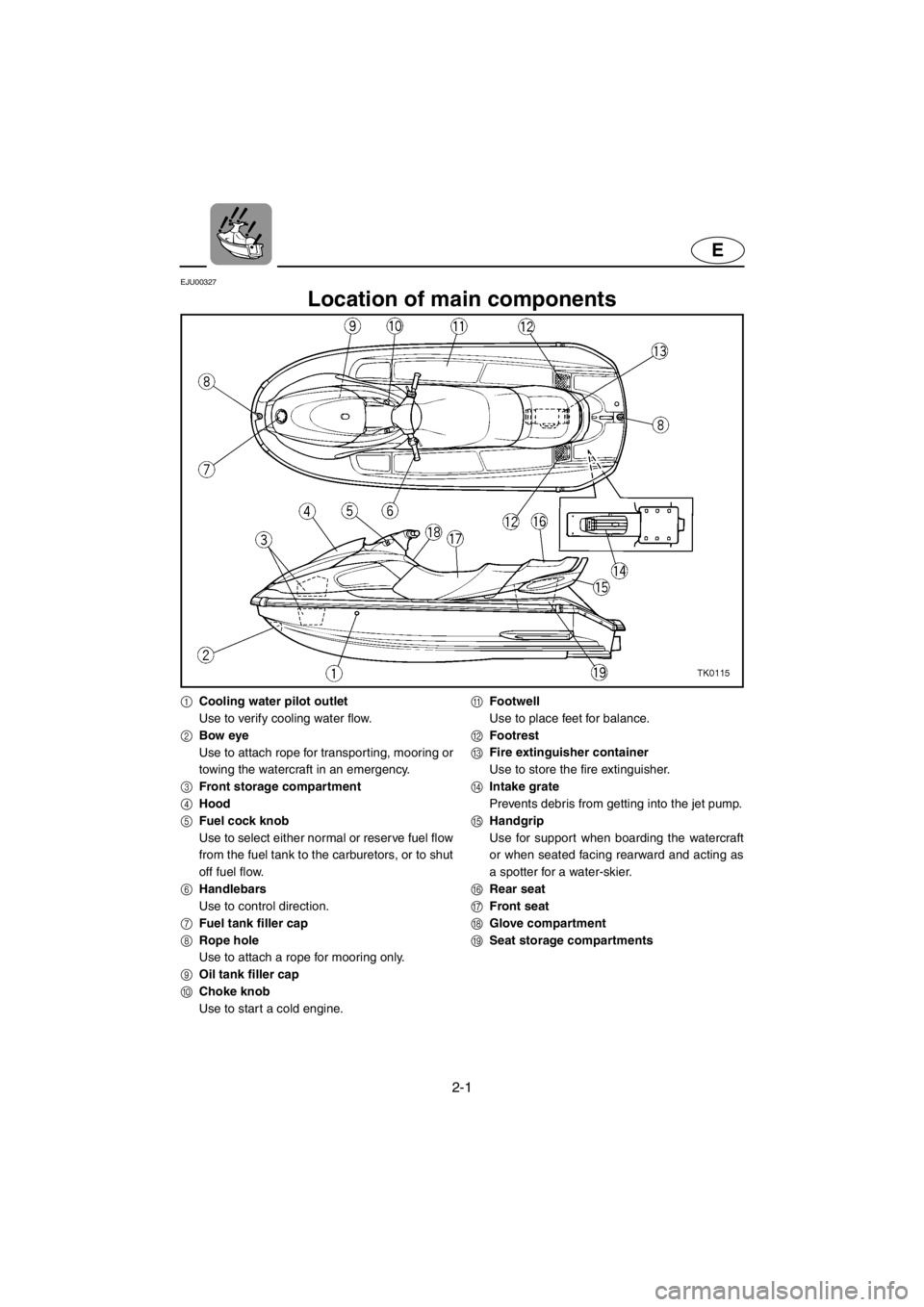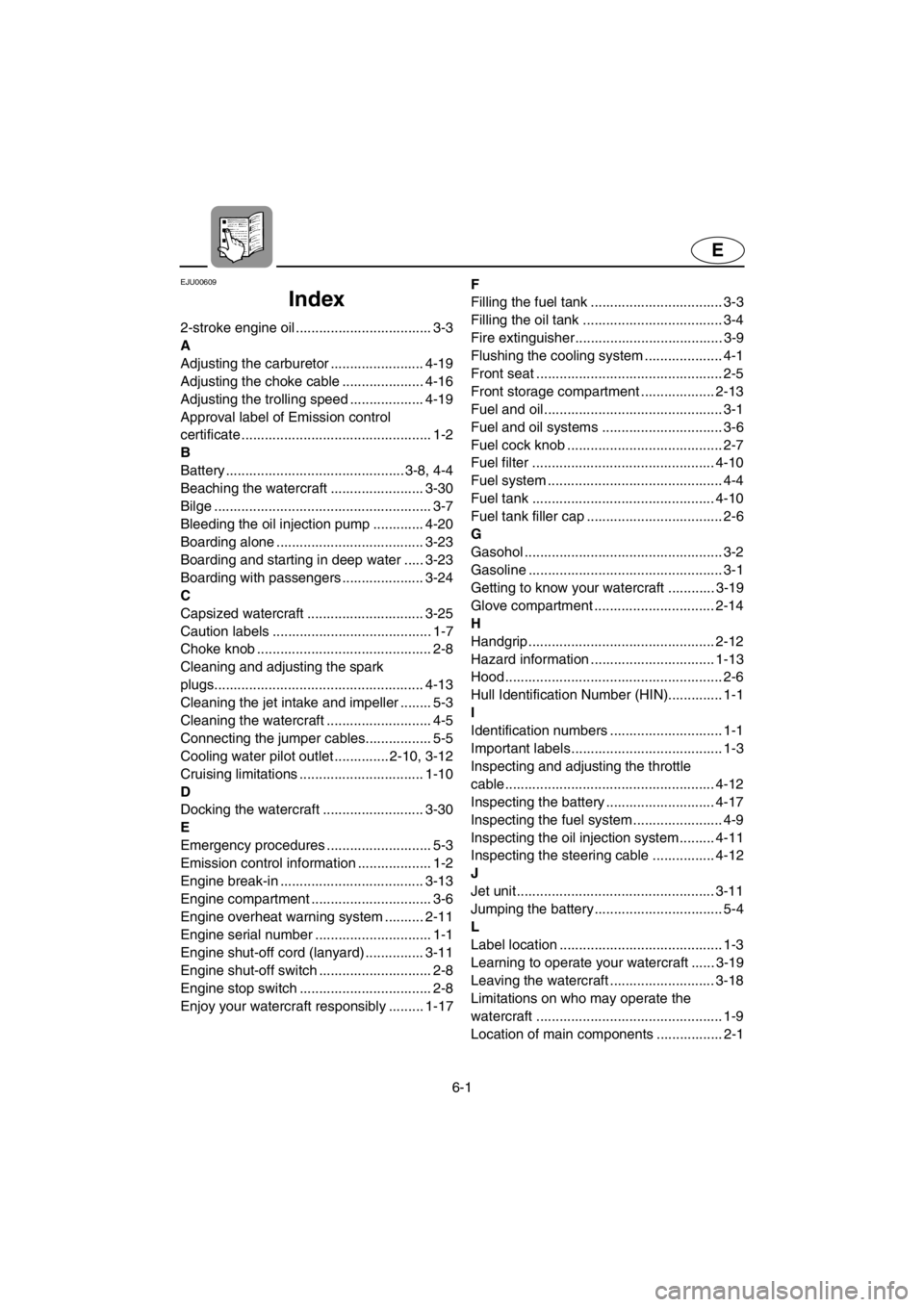fuel pump YAMAHA XL 700 2001 Owners Manual
[x] Cancel search | Manufacturer: YAMAHA, Model Year: 2001, Model line: XL 700, Model: YAMAHA XL 700 2001Pages: 111, PDF Size: 12.05 MB
Page 26 of 111

2-1
E
EJU00327
Location of main components
1Cooling water pilot outlet
Use to verify cooling water flow.
2Bow eye
Use to attach rope for transporting, mooring or
towing the watercraft in an emergency.
3Front storage compartment
4Hood
5Fuel cock knob
Use to select either normal or reserve fuel flow
from the fuel tank to the carburetors, or to shut
off fuel flow.
6Handlebars
Use to control direction.
7Fuel tank filler cap
8Rope hole
Use to attach a rope for mooring only.
9Oil tank filler cap
0Choke knob
Use to start a cold engine.AFootwell
Use to place feet for balance.
BFootrest
CFire extinguisher container
Use to store the fire extinguisher.
DIntake grate
Prevents debris from getting into the jet pump.
EHandgrip
Use for suppor t when boarding the watercraft
or when seated facing rearward and acting as
a spotter for a water-skier.
FRear seat
GFront seat
HGlove compartment
ISeat storage compartments
E_F0M-72-2.fm Page 1 Thursday, July 27, 2000 9:50 AM
Page 43 of 111

3-2
E
CAUTION:
Use only fresh gasoline that has been
stored in clean containers.
Gasohol
There are two types of gasohol: gasohol
containing ethanol and that containing meth-
anol.
Gasohol containing ethanol can be used
if ethanol content does not exceed 10 % and
the fuel meets minimum octane ratings.
Gasohol containing methanol is not rec-
ommended by Yamaha because it can
cause fuel system damage or engine perfor-
mance problems.Recommended gasoline:
Regular unleaded gasoline with
a minimum octane rating of
86 (Pump octane number) = (R+M)/2
90 (Research octane number)
E_F0M-72-3.fm Page 2 Thursday, July 27, 2000 9:52 AM
Page 75 of 111

E
4
EJU00515
MAINTENANCE AND
CARE
Storage....................................................... 4-1
Flushing the cooling system ................... 4-1
Lubrication............................................... 4-3
Fuel system............................................. 4-4
Battery ..................................................... 4-4
Cleaning the watercraft........................... 4-5
Maintenance and adjustments............... 4-6
Owner’s/Operator’s Manual and tool
kit ............................................................. 4-7
Periodic maintenance chart .................... 4-8
Inspecting the fuel system ...................... 4-9
Inspecting the oil injection system........ 4-11
Inspecting the steering cable................ 4-12
Inspecting and adjusting the throttle
cable ...................................................... 4-12
Cleaning and adjusting the spark
plugs ...................................................... 4-13
Lubrication points .................................. 4-14
Adjusting the choke cable..................... 4-16
Inspecting the battery ........................... 4-17
Adjusting the carburetor ....................... 4-19
Replacing the fuse ................................ 4-20
Bleeding the oil injection pump............. 4-20
Specifications......................................... 4-21
E_F0M-72-4TOC.fm Page 1 Thursday, July 27, 2000 9:53 AM
Page 84 of 111

4-9
E
EJU00537
Inspecting the fuel system
WARNING
Gasoline and its vapors are highly flam-
mable and explosive.
Check the fuel system for leaks, cracks,
or malfunctions. If any problem is found, do
the necessary repair or replacement as
required. If repair is necessary, consult a
Yamaha dealer.
Check:
●Carburetor for leakage.
●Fuel pump for malfunction or leakage.
●Fuel tank for water or dirt.
●Fuel tank for damage, cracks or leakage.
●Fuel hose joint for leakage.
●Fuel hose for cracks or other damage.
●Fuel filter for leakage.
●Fuel cock for leakage.
●Air vent check valve for leakage.
●Fuel tank filler cap for damage.
WARNING
Failure to check for and repair any fuel
leakage may result in fire or explosion.
E_F0M-72-4.fm Page 9 Thursday, July 27, 2000 9:53 AM
Page 96 of 111

4-21
E
EJU00588
Specifications
MODEL
ITEMUnit XL700
WATERCRAFT CAPACITY
Maximum people on board Number of people 3
Maximum load capacity kg (lb) 240 (530)
DIMENSIONS
Length mm (in) 3,150 (124.0)
Width mm (in) 1,250 (49.2)
Height mm (in) 1,100 (43.3)
Dry weight kg (lb) 245 (540)
PERFORMANCE
Maximum output kW (PS) @ r/min 58.8 (80)@6,250
Maximum fuel consumption L/h (US gal/h, Imp gal/h) 34.0 (9.0, 7.5)
Cruising range at full throttle hr. 1.5
Trolling speed r/min 1,250–1,350
ENGINE
Engine type 2-stroke
Number of cylinders 2
Engine displacement
cm
3 (cu in)701 (42.78)
Bore & stroke mm (in) 81.0 ×
68.0 (3.19 ×
2.68)
Compression ratio 7.2
Lubrication system Oil injection
Cooling system Water-cooled
Starting system Electric starter
Ignition system C.D.I.
Spark plug BR8HS
Spark plug gap mm (in) 0.6–0.7 (0.024–0.028)
Battery capacity V-AH 12-19
Charging system Flywheel magneto
DRIVE UNIT
Propulsion system Jet pump
Jet pump type Axial flow, single stage
Impeller rotation Counter clockwise (Rear view)
Transmission Direct drive from engine
Jet thrust nozzle angle Degree 24 + 24
FUEL AND OIL
Recommended fuel Regular unleaded gasoline
Minimum octane rating PON
RON86
90
Recommended engine oil YAMALUBE 2-W, or an equivalent NMMA-
certified TC-W3 marine oil
Fuel tank capacity
Total L (US gal, Imp gal) 50 (13.2,11)
Reserve L (US gal, Imp gal) 12 (3.17, 2.64)
Oil tank capacity L (US gal, Imp gal) 3.8 (1.00, 0.84)
E_F0M-72-4.fm Page 21 Thursday, July 27, 2000 9:53 AM
Page 106 of 111

6-1
E
EJU00609
Index
2-stroke engine oil ................................... 3-3
A
Adjusting the carburetor ........................ 4-19
Adjusting the choke cable ..................... 4-16
Adjusting the trolling speed ................... 4-19
Approval label of Emission control
certificate ................................................. 1-2
B
Battery .............................................. 3-8, 4-4
Beaching the watercraft ........................ 3-30
Bilge ........................................................ 3-7
Bleeding the oil injection pump ............. 4-20
Boarding alone ...................................... 3-23
Boarding and starting in deep water ..... 3-23
Boarding with passengers ..................... 3-24
C
Capsized watercraft .............................. 3-25
Caution labels ......................................... 1-7
Choke knob ............................................. 2-8
Cleaning and adjusting the spark
plugs...................................................... 4-13
Cleaning the jet intake and impeller ........ 5-3
Cleaning the watercraft ........................... 4-5
Connecting the jumper cables................. 5-5
Cooling water pilot outlet .............. 2-10, 3-12
Cruising limitations ................................ 1-10
D
Docking the watercraft .......................... 3-30
E
Emergency procedures ........................... 5-3
Emission control information ................... 1-2
Engine break-in ..................................... 3-13
Engine compartment ............................... 3-6
Engine overheat warning system .......... 2-11
Engine serial number .............................. 1-1
Engine shut-off cord (lanyard) ............... 3-11
Engine shut-off switch ............................. 2-8
Engine stop switch .................................. 2-8
Enjoy your watercraft responsibly ......... 1-17F
Filling the fuel tank .................................. 3-3
Filling the oil tank .................................... 3-4
Fire extinguisher ...................................... 3-9
Flushing the cooling system .................... 4-1
Front seat ................................................ 2-5
Front storage compartment ................... 2-13
Fuel and oil.............................................. 3-1
Fuel and oil systems ............................... 3-6
Fuel cock knob ........................................ 2-7
Fuel filter ............................................... 4-10
Fuel system ............................................. 4-4
Fuel tank ............................................... 4-10
Fuel tank filler cap ................................... 2-6
G
Gasohol ................................................... 3-2
Gasoline .................................................. 3-1
Getting to know your watercraft ............ 3-19
Glove compartment ............................... 2-14
H
Handgrip ................................................ 2-12
Hazard information ................................ 1-13
Hood........................................................ 2-6
Hull Identification Number (HIN).............. 1-1
I
Identification numbers ............................. 1-1
Important labels ....................................... 1-3
Inspecting and adjusting the throttle
cable...................................................... 4-12
Inspecting the battery ............................ 4-17
Inspecting the fuel system ....................... 4-9
Inspecting the oil injection system ......... 4-11
Inspecting the steering cable................ 4-12
J
Jet unit................................................... 3-11
Jumping the battery ................................. 5-4
L
Label location .......................................... 1-3
Learning to operate your watercraft ...... 3-19
Leaving the watercraft ........................... 3-18
Limitations on who may operate the
watercraft ................................................ 1-9
Location of main components ................. 2-1
E_F0M-72IX.fm Page 1 Thursday, July 27, 2000 9:58 AM